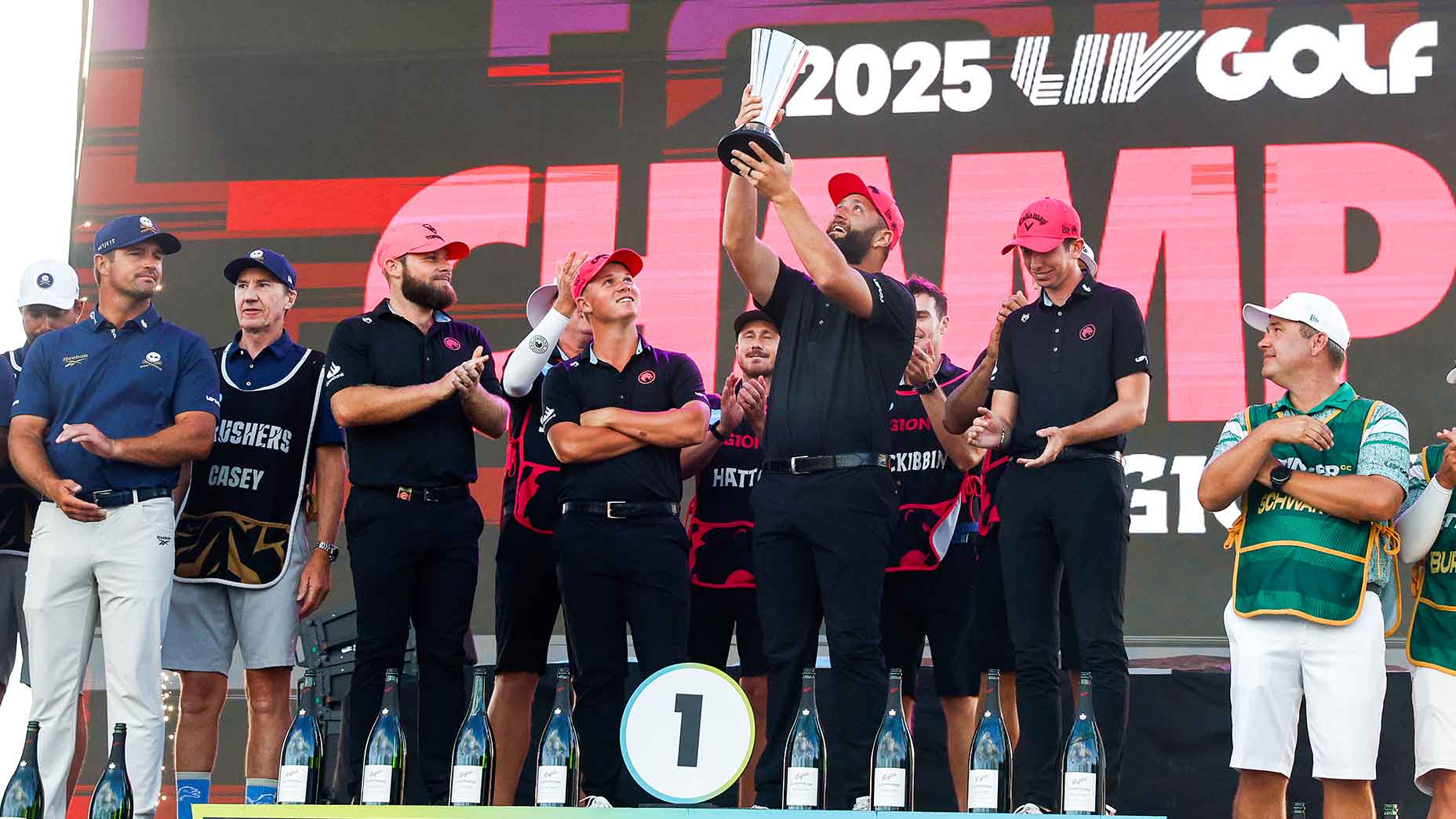ORLANDO, Fla. — The category is, Things Nobody Says in the Golf Business.
The answers are:
a. Hey, let’s start a company and make golf balls.
b. Since Cleveland is the Heart of Rock ‘n Roll, let’s locate our new business in the Home of Golf — Buffalo, N.Y.
c. Let’s come up with an equipment innovation that the United States Golf Association, which is deathly afraid of missing yet another revolutionary game-changing idea, is almost sure to outlaw.
d. All we need is a way to make golf harder, slower and more expensive and we’ll be rich.
Give yourself a low five for guessing that “d” is the only wrong answer. And give the guys at OnCore Golf credit for still being here despite a business plan that’s as simple as a, b, c.
Golf balls? Trying to get in the ball business almost sank Callaway Golf when it was at the peak of its success. How are you going to compete against the big boys — Titleist, TaylorMade and Nike — who have millions in marketing dollars?
Buffalo? The home of golf business headquarters is Carlsbad, Calif., where TaylorMade, Callaway and Cobra are located. Even Titleist, which is based in Massachusetts, has a test center in Carlsbad. Buffalo is where lake-effect snow goes to be shoveled.
The USGA? Does anybody, even if they’re right, win an argument with the USGA?
Steve Coulton laughs at every scenario. He and OnCore co-founder Bret Blakely have heard it all already. OnCore Golf is still alive and kicking, even if sometimes it seems like an old Jeff Bridges-James Woods movie, “Against All Odds.” No doubt, Coulton figures, the guy who started UnderArmour heard the same dire predictions about going up against Nike and all the other big sportswear companies.
“Sons don’t necessarily want to wear or play what their father or grandfathers are wearing,” Coulton said. That is definitely true in fashion. But Buffalo? OK, it’s actually a pretty good golf city, like a lot of northern cities where a short season somehow makes the golfers even more avid. But why not move south to someplace “warmer” like Harrisburg or Scranton? Rumor has it that Dunder Mifflin has warehouse space available in the latter.
Coulton laughs again. “With technology now, you can start a company from a boat on the middle of the ocean,” he said.
OnCore Golf is still in business, despite the odds, because it has, indeed, come up with a technological innovation. Its product is a golf ball with a hollow metal core. That’s right, in the space where that squishy liquid center was 50 year ago, the OnCore ball is all air around a high-performance polymer shell. The original OnCore working model had a 1.1 inch diameter hollow center. After testing and fine-tuning, OnCore settled on a .9-inch hollow-core center.
Why did any of this happen? Because an engineer, Doug DuFaux, got tired of hitting big hooks and missing fairways so he wanted to design a ball that had less sidespin and flew straighter. Golfer, heal thyself.
The OnCore story comes in three parts. One, design and build a ball. Two, get it approved. Three, figure out how to sell it.
Blakely and Coulton were unlikely golf company founders. They met through New York University. Coulton was working in finance, Blake had a job in international marketing. Coulton was a pretty good golfer and Blakely mentioned that his father, Keith, had a company (Nano Dynamics) that had a side project that was creating a new golf ball (designed by DuFaux) with better spin and flight characteristics. The basic idea was that if perimeter weighting made better golf clubs, why wouldn’t it make a better golf ball, too? What better way to perimeter-weight a ball than by having no weight in the center?
The first prototype had a stainless steel shell around a 1.1 inch hollow core.
“It had this thin layer of rubber around it, it felt like a rock,” Coulton said. “But it was wicked straight, It was 70 percent straighter but lost a lot in distance, so it wasn’t going to be a commercial success.”
Months of prototypes and testing led OnCore to the current .9-inch diameter.
“It’s got more cushion now,” Coulton said. “We lost some of the accuracy advantage but it’s still more accurate than traditional balls.”
His usual explanation of the technology is to liken it to an ice skater who spins faster with arms tucked in and when it’s time to slow down, the skater extends the arms. “The weight is centered in a rubber-core ball so you have an increase in side spin,” he said. “The hollow metal core pushes that weight to the perimeter, so you’re slowing down that sidespin.”
Long story, short: Blakely and Coulton licensed the technology and went off on their own, starting OnCore Golf, and eventually bringing DuFaux on board.
It took about two years from start to finish. Designing and building the ball was the first challenge. The ball is manufactured through partnerships in the U.S. and in Asia (China), by the way.
The bigger challenge may have been getting the USGA to put the OnCore ball on the list of conforming golf balls. That took a year by itself.
OnCore submitted its ball and the USGA denied it, saying the ball did not meet their requirements as “being of traditional and customary form and make.”
“They created that rule in 2008 and they had it for clubs,” Coulton said. “Historically, there were always just five metrics for balls — weight, total distance, symmetry, diameter and initial velocity. We knew we met all of those standards so we appealed.”
There had been golf balls, Coulton said, that were approved and the companies who marketed the balls used phrases such as “never-before seen materials,” a “hammer-blow to tradition,” and “revolutionary.” “So if they’re saying that, they couldn’t have been traditional, either,” he said. “It seemed arbitrary.”
How do you tell the USGA they’re being hypocritical a–holes? You keep appealing.
That meant a lot of paperwork and letters. OnCore’s first appeal went to the USGA’s equipment committee, which denied the appeal. Then it went to the executive committee, which heard a 15-minute presentation from OnCore over the phone, which was followed by documents of supporting evidence that included information provided by the USGA that a version of a hollow-core ball had been approved once in the past.
“I thought we had a 50-50 chance, Bret thought we had a one percent chance,” Coulton said.
In October 2013, an email from the USGA arrived that said a rules change had been made that a ball with rigid cores of .9 inch or less will be deemed permissible. OnCore was in business.
“They said it was only the second time in history, since the liquid core ball in 1921, that they made an exception or allowance for a golf ball,” Coulton said. “It was a big moment in the company’s history.”
When Coulton got the news, he was at a fund-raiser at a church on the Canisius College campus.
“I’m not super-religious but I was in a church and I looked up and gave thanks,” he said. “I had a celebration internally. It was the best feeling in the world.”
Later, he and Blakely went to Tappo, a Buffalo restaurant and bar that used to be a coffee distribution center, and celebrated with a few drinks.
“Just beer,” Coulton said. “Craft beer. That symbolized us because we’re a craft golf ball company.” Now, OnCore is in the selling and distribution part of the program. The balls go for $45 a dozen. Getting them on shelves in stores or golf shops is an equally daunting task but they’re making slow progress. A successful appearance on CNBC’s “Power Pitch” show helped. You can check them out online at www.OnCoreGolf.com.
The OnCore balls have a little different sound to them at impact, a slightly more metallic tink, but they seem to perform comparably to other popular brands. My limited testing was done in November with chilly temperatures and soft course conditions so I couldn’t make any conclusions about how the ball checked up on the greens. I kind of liked the sound the ball made once I got used to it and I busted a couple of drives that went suitably far, so I didn’t see any issue with distance.
“We had a pro win a section event here in Buffalo with it,” Coulton said, “and we had an 80-year-old woman write in. She made a hole-in-one with the ball, which she’d just found on the course. You hear that kind of thing, it makes you feel good.”
It provides a warm feeling. In Buffalo, the Home of Golf, that’s a good thing.
And now for your Van Cynical Mailbag questions:
VanCynical, Isn’t Tiger’s missing tooth the same one that turned brown after the hydrant incident?-Bustinpar via Twitter
You mean the one that required oral surgery to repair and he had to leave town to get it done and wasn’t seen for a few days? Nah, that never happened, remember?
Van the Man Cynical, Think Tiger gets his intimidation aura back with skull mask and missing tooth? Maybe if he sharpened the other to a point?-Kris B via Twitter
That might be worth trying, wearing a skull mask in competition. It would scare me if I was in that threesome. I think Tiger was just trying to escape the trappings of fame and wear a mask so he wouldn’t be recognized and bothered. He just wanted to mingle with the people, probably. Big fame will wear you out.
Van Cynical, Does a non-contending Tiger WD from Phoenix if the Sunday round won’t finish in time to make the Super Bowl?-Brian Bailey via Twitter
Not to worry. They’ll hold up the kickoff until Tiger gets there. Or face Lindsey Vonn’s wrath!
Van Sickle, You’re still pressuring me over my lack of progress on “The Robot Who Won the Masters after WW III”?-John Garrity via Twitter
That’s right, John. You’d better hurry up and finish it that novel before WWIII actually starts. Clock is ticking, buddy.
Vans, I gave up. Did they ever find anything?-Mark Greenhalgh via Twitter
This was in response to my suggested T-shirt, “I dug for treasure on Oak Island and all I got was this crummy TV show.” They think they found something, Greenie, in the season two finale-a cavern and two rectangular-shaped possible entrances into tunnels, plus a rectangular object and something that looks like a box or chest. And now we’ve got to wait until next season to find out if our favorite geniuses can figure out a way down there. My guess is, no. But I keep watching the show, thinking that something has to happen sooner or later, doesn’t it?
Van Comical, Since players can’t throw stuff into the crowd now, who is the best choice to lead the #Yes chant on 16 in Phoenix?-Brian Baily via Twitter
Bubba Watson and Ben Crane aren’t afraid to put on a show at 16. I’ll nominate them. If you can’t throw stuff into the crowd, can you hand things carefully to spectators? Hold a raffle? Invite a fan down to play Plinko? Juggle stuff? Rule needs more clarity, man.
Sickle, The tour says no swag-throwing at Phoenix’s 16th hole. What’s the penalty for ignoring this guidance?-kokomice via Twitter
Probably a substantial fine, two knuckle raps and three demerits for misbehavior-but since it’s pro golf, it’s three Jimmy Demarets.
For more news that golfers everywhere are talking about, follow @si_golf on Twitter, like us on Facebook, and subscribe to our YouTube video channel.






